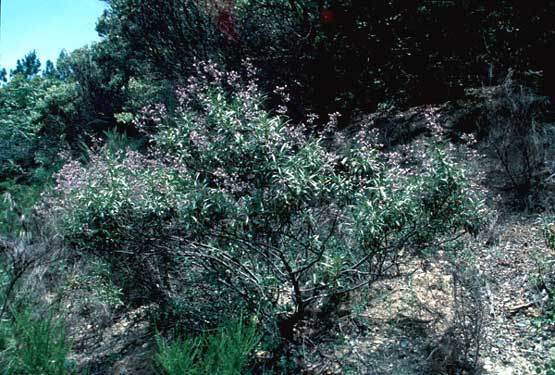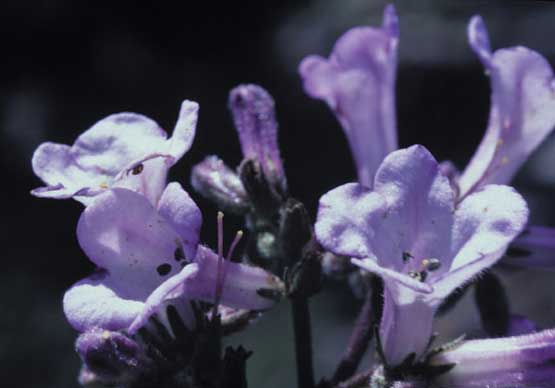|
Yerba Santa
The common names of Yerba Santa include Mountain Balm, Bear's Weed, Gum Plant, Consumptive Weed, and Sacred Herb. It was used medicinally by Native America healers for many centuries, and then taken up by the Spanish settlers, who gave it its current name, meaning "Holy Herb."
Yerba Santa is an exceptional member of the Waterleaf Family (Hydrophyllaceae) which also contains Phacelia, Baby Blue Eyes and Fiesta Flower. Most of these family members grow in cool, moist habitats, indicating a strong relationship to the watery element. Yerba Santa also has a relationship with water, although in an opposite way. With its tough, resinous leaves, it holds and conserves its water from the inside to meet the intense fire of its environment. This quality helps us to understand the medicinal use of Yerba Santa as a regulator of the water element. Yerba Santa coats the mucous membranes and holds the aqueous component in contact with the cells, reestablishing mucopolysaccharides. As such, it is an excellent herbal remedy for chronic respiratory ailments, used as an expectorant used to treat coughs and congestion, as well as aiding in loosening and expelling phlegm. It dilates bronchial tubes, and thus is used to ease asthma and allergy attacks. A tea, tincture or syrup is typically made from the leaves, sometimes including the flowers, or as a smoke from the leaves.
Yerba Santa frees the lungs and heart to acknowledge and release stored emotional experience. Yerba Santa was regarded as a holy herb by the naitive peoples, because the process of awakening, and claiming deep soul experience leads to the indwelling Temple of the Spiritual Self. It is often in those places where the soul retains the most profound pain or trauma, that the strongest teachings of the Spiritual Self can also be realized. The color and form of the Yerba Santa is truly a signature of these soul qualities—the delicate lavender flowers suggest a highly refined level of spiritual awareness. And at the same time the curving, tubular shaped flowers speak to a process of descent into the deepest parts of the soul temple. The insights of Matthew Wood, in Seven Herbs Plants as Teachers capture in a most touching way, these qualities of Yerba Santa:The inner spaces defined by the body lining are "sanctuaries," from which impurities must be kept. Perhaps it was an intuitive recognition of this which gave the plant its name: Yerba Santa...the internal body linings correspond with "psychic body linings." Sanctity of psychic space is the internal property which Yerba Santa guards.
|

To install this Web App in your iPhone/iPad press ![]() and then Add to Home Screen.
and then Add to Home Screen.
 Yerba
Santa is an evergreen aromatic shrub with woody rhizomes, typically
growing to a height of 3 to 4 feet (1 m +) The dark green, leathery
leaves are oblong to lanceolate and covered with shiny resin. They
grow in an alternate arrangement and are pinnately veined and usually
serrate. The taste of the leaves is balsamic and the flowers and
leaves smell pleasantly aromatic on a warm day. Yerba Santa is native
to the western and southwestern regions of North America, and is
somewhat native to northern Mexico. It grows 2-6 feet in height at
elevations ranging from 2000 to 3,500 ft. It is typically found in
dry areas that are sparse of other vegetation. The flowers are a
delicate whitish-lavender color, found in curved tubular clusters
(helicoid cymes) at the top of the plant, and are pollinated by butterflies.
Yerba Santa blooms from May to July, depending on the elevation.
The fruit forms a grayish-brown seed capsule, oval in shape, which
contains hardened black seeds.
Yerba
Santa is an evergreen aromatic shrub with woody rhizomes, typically
growing to a height of 3 to 4 feet (1 m +) The dark green, leathery
leaves are oblong to lanceolate and covered with shiny resin. They
grow in an alternate arrangement and are pinnately veined and usually
serrate. The taste of the leaves is balsamic and the flowers and
leaves smell pleasantly aromatic on a warm day. Yerba Santa is native
to the western and southwestern regions of North America, and is
somewhat native to northern Mexico. It grows 2-6 feet in height at
elevations ranging from 2000 to 3,500 ft. It is typically found in
dry areas that are sparse of other vegetation. The flowers are a
delicate whitish-lavender color, found in curved tubular clusters
(helicoid cymes) at the top of the plant, and are pollinated by butterflies.
Yerba Santa blooms from May to July, depending on the elevation.
The fruit forms a grayish-brown seed capsule, oval in shape, which
contains hardened black seeds.

 A
picture of the soul qualities of the Yerba Santa essence emerges
from this botanical herbal portrait. Yerba Santa flower essence
is indicated for those who hold in the water element, especially
manifest
in the emotions of grief, melancholy, depression or despair.
These emotions are stored in the deeper cavities of the body,
particularly
in the heart/ lung/respiratory region. The free flowing, or "breathing
out" of soul expression is often impeded. Respiratory illnesses,
addiction to tobacco, and various allergies are common physical
manifestations of this soul imbalance.
A
picture of the soul qualities of the Yerba Santa essence emerges
from this botanical herbal portrait. Yerba Santa flower essence
is indicated for those who hold in the water element, especially
manifest
in the emotions of grief, melancholy, depression or despair.
These emotions are stored in the deeper cavities of the body,
particularly
in the heart/ lung/respiratory region. The free flowing, or "breathing
out" of soul expression is often impeded. Respiratory illnesses,
addiction to tobacco, and various allergies are common physical
manifestations of this soul imbalance.

